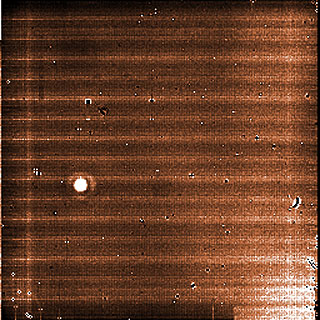VISIR
VLT Imager and Spectrometer for mid-Infrared
Take a few minutes to look at the night sky on a dark night and you will notice that there are several huge black areas in the Milky Way. Is there something out there? Or are there just empty black spaces between the stars?
For years, astronomers have wondered the same thing. The truth is that many of these dark areas are no more than dusty zones blocking the visible light coming from the stars. That means that the light that your eyes can see is absorbed by the dust, leaving astronomers working in visible light blind, with no information to analyse from these regions.
 The VLT Imager and Spectrometer for mid-InfraRed or VISIR is one of the tools that astronomers use to get around this problem. This instrument was installed on the VLT in 2004, and it can study the infrared light from celestial objects. Why infrared? This kind of light, with a longer wavelength than the visible (up to 40 times longer), propagates much better through dust clouds, allowing astronomers to study remarkable objects and processes like the formation and evolution of the stars, the stellar wind, molecular clouds and protostars that would otherwise hidden behind the clouds.
The VLT Imager and Spectrometer for mid-InfraRed or VISIR is one of the tools that astronomers use to get around this problem. This instrument was installed on the VLT in 2004, and it can study the infrared light from celestial objects. Why infrared? This kind of light, with a longer wavelength than the visible (up to 40 times longer), propagates much better through dust clouds, allowing astronomers to study remarkable objects and processes like the formation and evolution of the stars, the stellar wind, molecular clouds and protostars that would otherwise hidden behind the clouds.
So VISIR is to dark nebulae what ultrasound is to medical inspections — it can look into hidden regions to study unborn babies — in VISIR’s case stellar embryos. In just 20 minutes, this instrument can acquire as many images or spectra as a 3- or 4-metre-class telescope is able to do in a whole night of observations, allowing astronomers obtain great results.
In principle it sounds easy, but it is not. It’s hard to believe, because you do not see it, but infrared light is everywhere. Earth's atmosphere, animals, machines and even your body emit infrared light.
This ubiquitous infrared light pollution can easily drown out the faint infrared signals from the sky, ruining the observations in the same way that visible light from the stars can be swamped by the light pollution from a city. So, engineers and astronomers have developed two techniques, called chopping and nodding, for detecting faint astronomical signals against this unwanted background pollution.
And there is one last problem.... If VISIR were at the same temperature as its surroundings, the metal and glass of VISIR would emit lots of infrared light which would overwhelm any faint mid-infrared astronomical signals. So, to avoid this effect, the whole VISIR instrument is cooled down to a temperature close to -250° C. Imagine: -250º C. That’s very cold! The two detectors in the instrument are kept even colder, at around -270°C, only a few degrees above absolute zero, the lower limit of temperatures (-273°C).
As part of the New Earths in the Alpha Cen Region (NEAR) project — a collaboration between ESO and the Breakthrough Initiatives — VISIR has been modified to greatly enhance its ability to search for potentially habitable planets around Alpha Centauri, the closest stellar system to the Earth. VISIR's performance has been enhanced using adaptive optics and a technique called coronagraphy, which reduces stellar light and thereby reveals the possible signal of potential terrestrial exoplanets.
So, next time that you see a black spot in the sky, try to imagine what it is behind the dust. Need a hint? Ask VISIR.
Science highlights with VISIR
- New image reveals vast nebula around famous supergiant star Betelgeuse (eso1121)
- VISIR looks deep into a huge storm on Saturn (eso1116)
- Scientists get a first look at weather inside the Solar System’s biggest storm, Jupiter’s Great Red Spot, using VISIR (eso1010)
- VISIR observations suggest that the supermassive black holes at the centres of galaxies help “to build” their own host galaxy (eso0946)
- VISIR discovered that the south pole of Neptune is much hotter than the rest of the planet (eso0741)
|
A raw image straight from VISIR. As the instrument observes in the thermal infrared, the individual exposures are extremely short, and the final image is obtained by combining hundreds, or even thousands, of individual snapshots obtained at slightly different positions. This technique allows astronomers to beat the incredibly bright background from the sky and from the telescope itself. It also allows them to correct for the many defects of the tiny detector, which appear here as dark and bright spots, as well as structure in the background. This image was one of the many that was used to produce the view of the star Betelgeuse further up this page. |
VISIRThe authoritative technical specifications as offered for astronomical observations are available from the Science Operation page.
|


